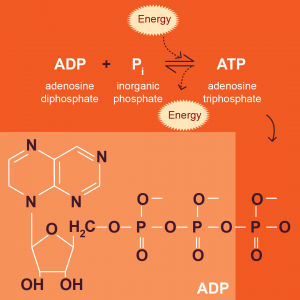Adenosine triphosphate (ATP)
One biologically important nucleotide that is not incorporated into DNA or RNA is adenosine triphosphate or ATP. ATP is a nucleotide because it consists of the pentose sugar ribose, the nitrogenous base adenine, and three phosphate groups. ATP is a form of energy currency within cells. When cells perform exergonic, catabolic reactions, the energy released is stored as chemical potential energy in ATP. When cells are ready to use that energy to perform endergonic, anabolic reactions, the energy is released from ATP by hydrolyzing the bonds in ATP molecules.


